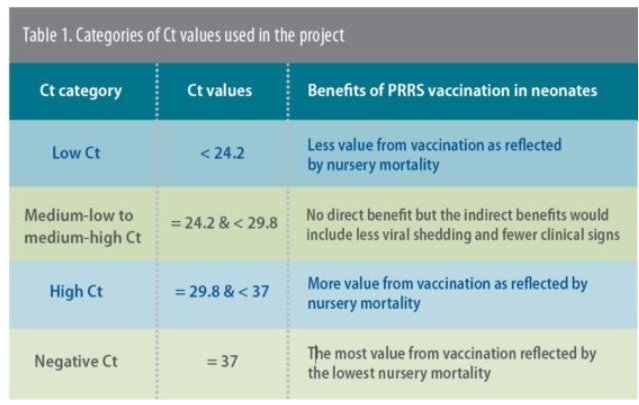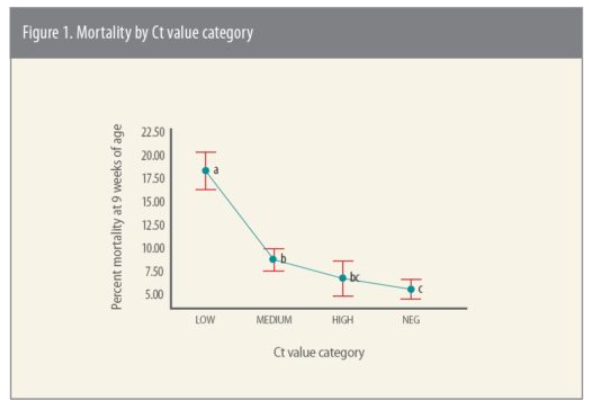



Ct values predict PRRS nursery mortality, can guide vaccination decisions
Obtaining cycle threshold (Ct) values based on processing fluids provides a practical way to identify neonatal pigs at risk for nursery mortality associated with porcine reproductive and respiratory syndrome (PRRS) and can help determine when vaccination is worthwhile, field research from Zoetis indicates.1
The approach to vaccination of pigs in herds positive for the PRRS virus varies widely in the swine industry, said PRRS specialist Jose Angulo, DVM, managing veterinarian, Zoetis.
Some producers never vaccinate neonates against PRRS if piglets are viremic. Some use a rule of thumb and vaccinate if the percentage of piglets with PRRS virus viremia is about 20% or less. Others vaccinate regardless of viremia because they want to reduce PRRS virus shedding even if vaccination doesn’t curb nursery mortality, he said.
“We’ve known that vaccinating pigs with PRRSV viremia reduces the duration of viremia and virus shedding, but we may not get the full benefit of vaccination.2 We don’t know if there is a level of viremia where vaccination will be beneficial,” Angulo said.
To answer that question, Angulo and colleagues initiated an epidemiological field investigation with a large Midwestern commercial swine system that had a history of PRRS on four sow farms.
Project setup
“We set out to evaluate nursery performance in piglets vaccinated against PRRS at processing, but we also wanted to create a model for making decisions about when to vaccinate piglets for PRRS using Ct values as the main indicator,” he said.
Each farm in the project had 3,000 sows that were vaccinated three times a year with Fostera® PRRS, a modified-live vaccine. The vaccine is an aid for preventing PRRS and is licensed for use in healthy, susceptible swine 1 day of age or older in herds positive for PRRS virus but also for negative pigs that may be exposed to the virus, Angulo explained.
At all four of the farms, staff was trained to collect processing fluids from piglets 4 to 5 days of age (see sidebar), with care taken to prevent sample contamination. Weekly pooled processing fluids were submitted to Iowa State University’s veterinary diagnostic laboratory, he said.
Piglets at one of the farms were vaccinated with Fostera PRRS after processing fluids were collected, Angulo said, and noted that sows at that farm broke with PRRS during the project. Piglets at the other three farms were not vaccinated, but nursery mortality at 9 weeks of age — the end of the nursery period — was tracked at all four farms to see if it differed between vaccinated and unvaccinated pigs. In vaccinated pigs, the researchers also determined if there was an association between mortality and the level of viremia.
More equals less
Ct values were determined by testing processing-fluid samples with reverse transcription polymerase chain reaction (RT-qPCR). It can take multiple cycles to identify the virus, and the number of cycles it takes determines the Ct value. When more virus is present, it takes fewer cycles to be identified. When less virus is present, it takes more cycles.
“We tested 264 processing-fluid samples and found a significant association between Ct values and 9-week mortality. As the Ct value increased, mortality in the nursery decreased,” said Angulo, who used statistical process tools to plot and track project results. “
In other words,” he said, “the effectiveness of PRRS vaccination is affected by viremia levels as measured by Ct values. Vaccination becomes less effective with lower Ct values — when more virus is present. Reaching a Ct value of 30 improves vaccine effectiveness because less virus is present.” (Table 1, Figure 1).
Lessons learned
“We’ve learned through testing of processing fluids that the PRRS virus is capable of circulating at a very low prevalence, demonstrated by high Ct values,” he noted.
Although vaccination of negative piglets is ideal, the project demonstrated there may be benefit to vaccinating neonatal piglets with low levels of viremia as indicated by high Ct values. Vaccination of piglets with moderate Ct values may not reduce nursery mortality but should convey the indirect benefits of less viremia and virus shedding and minimization of PRRS clinical signs,3 Angulo continued.


Notes: Generalized linear mixed model. Turkey pairwise comparisons.Mortality means that do not share a letter are significantly different (P-value = 0.001).
Red flag
He cited data from published studies on the impact of PRRS on pre-weaning piglets. Mortality can increase by as much as 10 to 40 percentage points during acute outbreaks. In piglets that survive, secondary infections become more prevalent,4 leading to treatment costs.
Low Ct values can serve as a red flag indicating groups of pigs with PRRS viremia that need intervention. “Those pigs may struggle more. If facilities are available, producers may want to segregate them. They may want to intensify management. The pigs may need antibiotic treatment for secondary bacterial infections,” Angulo said.
Based on his experience, he would recommend producers routinely test processing fluids and obtain Ct values to assess the PRRS farm status because it’s an easy and inexpensive surveillance method.
“The cost of testing 30 piglet serum samples pooled by five would pay for testing six aggregate processing-fluid samples, and the aggregate samples represent many hundreds of piglets,”5 Angulo pointed out.
“The ability to determine when PRRS vaccination of pigs at processing is worthwhile could help substantially minimize the losses PRRS inflicts on nursery pigs and on producer profits,” he said.
PROCESSING FLUIDS
Processing fluids provide aggregate samples of fluids. Testicles and tails removed during processing are put into a bucket lined first with a plastic bag and then cheesecloth, which are secured around the top of the bucket with a large rubber band.
Fluids from the tissues drain through the cheesecloth into the plastic bag. After collection, a small hole is made into the bottom of the plastic bag. Fluids flow through, then are poured into vials and sent to a lab for testing.
“Processing fluids provide an easy and inexpensive way of monitoring disease, and it’s increasing in popularity due to its simplicity,” Angulo said. Other investigators have found that testing processing fluids for PRRS virus RNA with polymerase chain reaction technology is more sensitive for detecting PRRS-positive pigs than PCR testing of blood sera or tail blood swabs.6
| References | ||||
|---|---|---|---|---|
| 1 Angulo J, et al. | ||||
| (2020) | Implementation of PRRS surveillance using processing fluids (PF) RT-PCR Ct value as predictor for nursery mortality. | 26th International Pig Veterinary Society Congress, 2020. | ||
| 2 Savard C, et al. Efficacy of | ||||
| (2016) | Fostera PRRS modified live virus vaccine against a Canadian heterologous virulent field strain of porcine reproductive and respiratory syndrome virus.. Can J Vet Res. | Jan;80(1):1-11. | ||
| 3 Ibid. | ||||
| 4 Holtkamp D, et al. | ||||
| (2013) | Assessment of the economic impact of porcine reproductive and respiratory syndrome virus on United States pork producers.. J Swine Health Prod. | 21(2):72. | ||
| 5 Lopez W, et al. | ||||
| (2018) | Porcine reproductive and respiratory syndrome monitoring in breeding herds using processing fluids.. J Swine Health Prod. | 26(3):146-150. | ||
| 6 Lopez W, et al. | ||||
| (2017) | Monitor herds for PRRS using processing-fluids samples. | Nov 6. | National Hog Farmer. |







